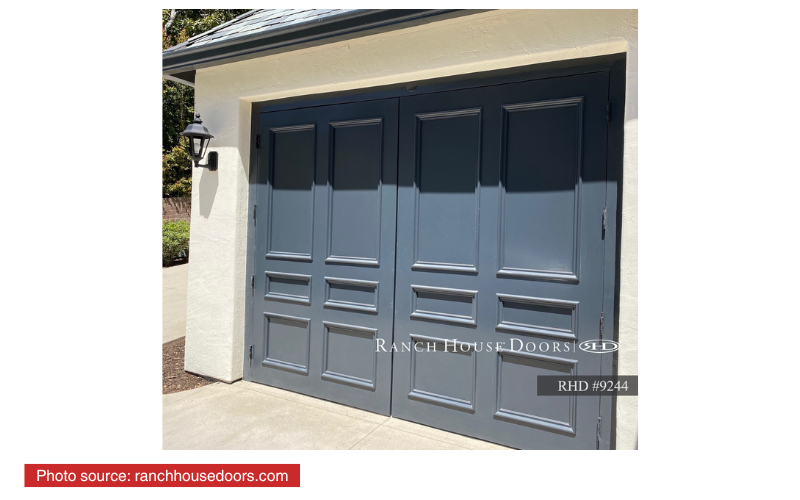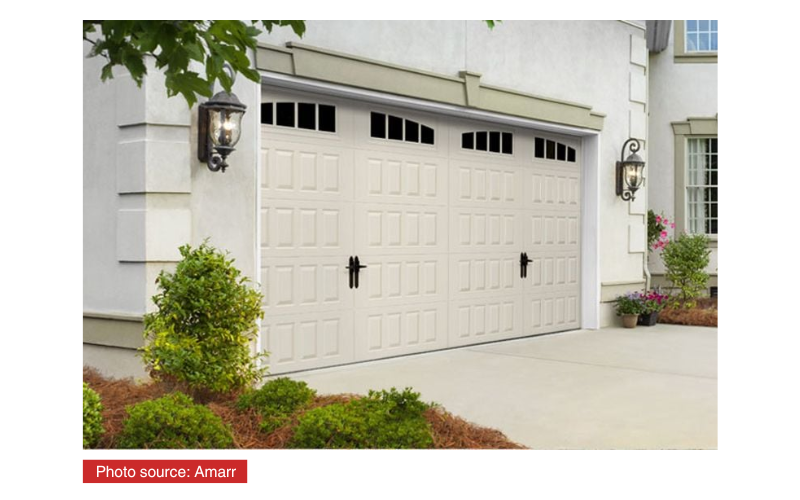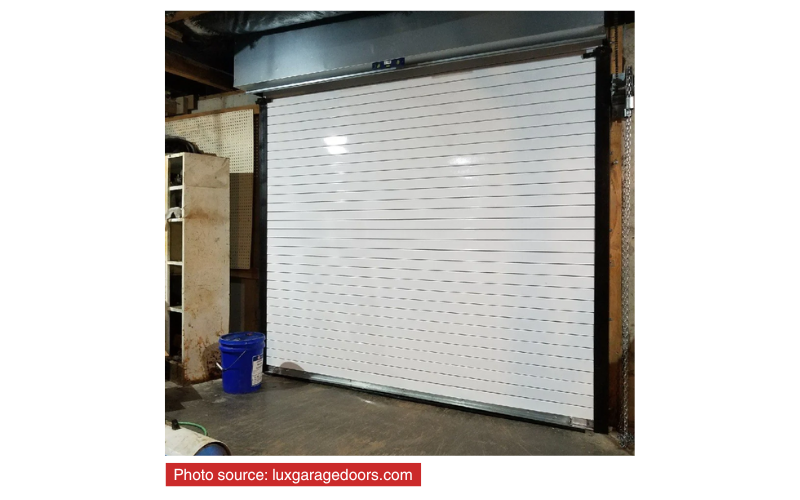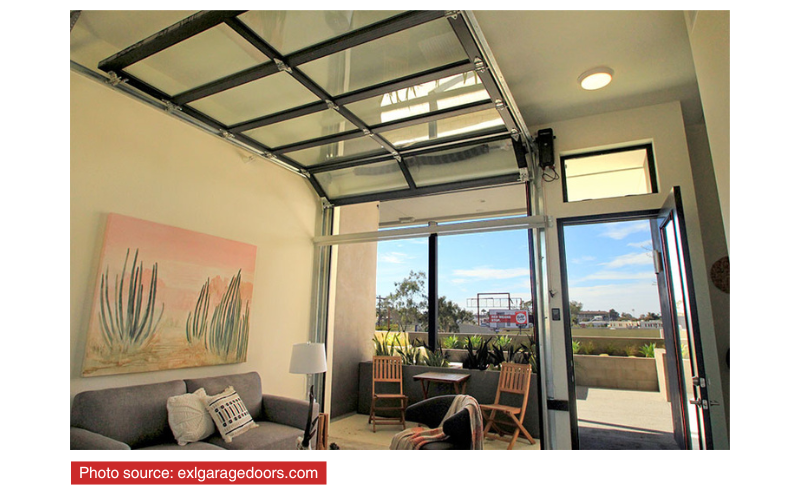7 Best Types of Garage Doors
More than a functional entryway, garage doors are important for the security and the overall look of our homes. It’s a key component of the first impression of your property and potentially affects its value. If you’re in the market for a new garage door but feeling overwhelmed by all the options, you’ve come to the right place! We’ll discuss the 7 best types of garage doors so you can find the one which is best for your home.
1. Swinging Garage Doors
Ideal for:
- Homes aiming for a classic or traditional appearance
- Properties where ceiling space is used for storage
- Garages converted into workshops or craft rooms
- Areas with frequent power outages, since they can be operated manually without power

Swinging garage doors, also known as swing-out, side-hinged, or carriage-style doors, use a simple and traditional hinge mechanism. Each door is attached with hinges on the sides of the garage’s opening, allowing them to swing outwards to open. The doors need to be at least 1 foot taller than it is wide to prevent them from sagging. They do require some clear space in front of the garage to operate. If space isn’t an issue, swinging doors are an excellent choice to for your home. These doors usually feature a latch for locking and may include handles or pulls for manual operation.
Common materials used to make swinging garage doors include wood, steel, or fiberglass. Wood is often chosen for its classic appearance but requires ongoing maintenance against weather effects. Steel is popular for its strength and security features, though it can rust in wet climates. Fiberglass stands out for its light weight and resistance to both rust and decay. Homeowners might select swinging garage doors to maintain a traditional look or to manage limited overhead space, as these doors do not use ceiling tracks. This door type is also beneficial for converting part of a garage into a workspace due to the easy access it facilitates.
2. Sliding Garage Doors
Ideal for:
- Saving wall space where traditional swing doors would interfere
- Modern home designs with sleek and minimalistic design
- Larger garage openings without the need for a reinforced overhead structure
- Environments where durability and ease of maintenance are important

Sliding garage doors, known for their space-saving design, operate along a track system positioned at the ground level and often also at the top of the door frame. This setup involves tracks laid out parallel to the garage wall, with the door panels sliding horizontally. This garage door is ideal for when the ceiling height is limited or when overhead space is utilized for storage, as there is no need for the clearance required by overhead doors. These doors can be easily automated for convenience. They can even have smart technology integration, utilizing modern locks and applications for convenience and safety.
These doors can be crafted from various materials such wood, steel, or aluminum. Wood is the popular classic. Steel and aluminum are preferred for their durability. The installation process is a less invasive setup as they don’t require heavy overhead tracks. Regular maintenance, as with all garage doors, is important such as cleaning the tracks and lubricating moving parts. Sliding garage doors are a practical and stylish option for garages that need a reliable and stylish garage door.
3. Bi-fold Garage Doors
Ideal for:
- Garages with limited headroom that cannot accommodate standard roll-up doors
- Compact areas where efficient use of space is essential
- Flexible room configurations

Bi-fold garage doors consist of panels connected by hinges, folding in the middle as they open. These doors operate on a track system that guides the folding action vertically, much like an accordion. Each panel folds onto the adjacent one as the door is lifted, either manually or with the aid of a motorized mechanism. This type of door is particularly beneficial in garages with limited overhead space, as they fold neatly and require less overhead or side space compared to traditional swinging or sliding doors. The compact folding mechanism makes bi-fold doors suitable for garages with limited headroom or where maintaining clear ceiling space is necessary for storage or other uses.
Bi-fold garage doors are usually made of aluminum, steel, and sometimes wood. Aluminum is lightweight and resistant to corrosion, making it suitable for garage environments where durability and low maintenance are priorities. Steel is selected for its strength, for those who need increased security and resistance to damage. Wood has the most visually appealing finish, but needs more maintenance. These doors are effective for garages that serve multiple purposes, such as workshops, home gyms or hobby areas, due to their practical design and efficient use of space.
4. Double Garage Doors
Ideal for:
- Households with multiple vehicles
- Garages that need large openings for equipment or vehicles like boats or trailers
- Homes with wide garage structures

Double garage doors are larger units designed to cover a wider garage opening, typically sufficient to accommodate two vehicles side by side. These doors can be operated either manually or with an electric opener, and they function using a range of mechanisms, including roll-up, swing-out, or slide to the side, depending on the homeowner’s choice and garage layout. They are available in a variety of styles, from traditional raised panels to contemporary flush designs. This type of door is especially practical for households with multiple vehicles or for those requiring large openings for items like boats or large equipment.
Materials such as steel, aluminum, wood, or fiberglass are commonly used for double garage doors. Steel doors are favored for their strength and security; aluminum is chosen for being lightweight; wood is common; and fiberglass is durable. The installation of double garage doors requires precise measurements and structural support due to their size so it is important to opt for professional installation. They can be equipped with modern features such as insulation and automatic openers.
5. Manual Garage Doors
Ideal for:
- Areas susceptible to frequent power interruptions
- Budget-conscious individuals preferring lower upfront and maintenance costs
- Those who prefer direct control on opening and closing the garage door
- Homeowners who want less mechanical complexity and potential repair needs

Manual garage doors operate without the assistance of an electric opener, relying instead on physical effort to open and close. This type of door is commonly found in older homes or in situations where simplicity and cost-effectiveness are prioritized. The operation of manual garage doors typically involves a locking mechanism that needs to be disengaged before the door can be lifted or swung open by hand. These doors may use a variety of mechanisms such as swing-out, roll-up, or slide to the side, but all require human force for movement. The absence of electrical components means that maintenance mostly involves the physical parts like springs, hinges, and tracks, which need regular lubrication and occasional adjustment to function smoothly.
Materials used in manual garage doors include wood, steel, and aluminum, each chosen based on factors like cost, weight, and durability. Manual garage doors can still have a high level of protection for the home by integrating modern security systems. Additionally, they are suitable in areas with frequent power outages, as they can be operated without electricity. They are also easier to maintain and for the most common issues, you can even go DIY fixes for this garage door .
6. Roll-up Garage Doors
Ideal for:
- Urban homes with limited driveway space
- Garages that need enhanced security
- Commercial properties or home workshops
- Climates with extreme weather conditions

Roll-up garage doors are composed of horizontal slats that coil around a drum located above the door opening when opened. This design is efficient for saving space as it does not require any interior or exterior clearance area like swinging or sliding doors. Roll-up doors are favored in both residential and commercial settings due to their durability and security features. The mechanism involves a spring-balanced motor that aids in the lifting and lowering of the door, although manual versions are also available. The rolling mechanism allows for smooth operation, and the compact design when opened minimizes garage space usage.
These doors are typically made from steel or aluminum. Steel roll-up doors are chosen for their strength and ability to secure premises, whereas aluminum doors provide a lighter alternative that resists corrosion and is suitable for garages in humid or coastal environments. Homeowners choose roll-up garage doors for their practicality. Additionally, the vertical operation ensures that the door does not obstruct exterior areas during operation, making it ideal for garages that face directly onto streets or where driveway space is limited. Despite looking utilitarian, roll-up doors can be customized in various finishes and colors to complement the exterior of any building.
7. Interior Garage Doors
Ideal for:
- Enhancing indoor-outdoor flow in homes with integrated living and patio areas
- Separating spaces in open-plan layouts
- Homes with modern industrial design themes
- Increasing the versatility of room uses, such as separating a home office from living areas

Interior garage doors are becoming a popular architectural feature in modern homes. It’s a stylish and versatile option to divide spaces while maintaining an open, airy feel. These doors operate smoothly on a track system to transition between indoor areas effortlessly. The use of glass panels ensures that natural light flows freely between rooms which work well in areas such as a living space or a home office or gym. Homeowners can modify the level of privacy thanks to the wide range of options for opacity. The sleek, minimalistic design of glass garage doors complements a variety of interior styles, from contemporary to industrial. Despite being stylish, these doors are still constructed with durability, using sturdy frames and tempered glass for safety.
Homeowners often fit these doors in kitchens as large, movable windows or skylights that open to introduce plenty of natural light and fresh air. These can also be used to divide the kitchen from the living room in open-plan homes, letting homeowners easily alternate between a secluded space for quieter moments and a larger area for social gatherings.
Summing it up
In conclusion, choosing the right types of garage door is important for both practicality and the overall look of your home. The traditional style of swinging doors, the clean functionality of sliding ones, the space-saving design of bi-folds, and the broad access provided by double doors, they all provide something unique that would be a preference of homeowners. For those who value easy maintenance, simplicity and cost-effectiveness, manual doors are a reliable choice, while roll-up doors stand out for their durability and efficient use of space. Side garage doors are built for convenience, and interior glass doors can make indoor spaces look more modern. It is important to weigh your options based on what matters most to you and your home. In the end, the best garage door is one that not only looks good but also meets the day-to-day demands of your household.





Comments are closed.